 |
December 2016
|
December 2016 // Volume 54 // Number 6 // Research In Brief // v54-6rb3
Southern Foresters' Perceptions of Climate Change: Implications for Educational Program Development
Abstract
An understanding of foresters' perceptions of climate change is important for developing effective educational programs on adaptive forest management. We surveyed 1,398 foresters in the southern United States regarding their perceptions of climate change, observations and concerns about climatic and forest conditions, and knowledge of and interest in resilient forest management techniques and climate science. A majority (61%) agreed that climate change is occurring, and 14% agreed that it is caused by humans. Most respondents were interested in learning more about forest resilience and related concepts. Development of programming focused on managing for forest resilience in a changing climate is a prudent educational approach that builds on familiar risk-management strategies.
Introduction
Climate change threatens forest health and viability and has the capacity to change the extent, composition, and growth of forest resources in the southern United States (Bettinger, Siry, & Merry, 2013). This region represents a unique and productive ecosystem that provides millions of residents with economic, social, and environmental benefits (Wear & Greis, 2013). Almost 90% of southern forests are privately owned by individuals, families, and timber and real estate investment interests (Bettinger, Siry, Cieszewski et al., 2013). It has been estimated that there are over 5 million of these owners in the South, with several hundred thousand owners controlling forested tracts of greater than 50 ac (Butler, 2008). The management decisions these owners make, coupled with the effects of changing climate and potentially catastrophic weather events, may affect the health and productivity of this vast resource.
Many private forest owners, however, do not fully understand the intricacies involved with managing forestland (Kittredge, 2004). Although they may have purchased or inherited large tracts of forested land, they may lack forestry expertise and, therefore, tend to delay important decisions, perhaps indefinitely (Butler et al., 2007). Professional foresters assist these private forest owners by developing forest management plans; recommending and implementing management practices; and overseeing, on behalf of the forest owners, contractors/loggers who provide certain services, including harvesting.
Discussions about sustainable forest management practices have begun to include references to impacts of and responses to climate change and catastrophic weather events. These complex issues pose significant challenges for professional foresters. (In fact, even the vocabulary used to discuss these issues can be confusing—see the appendix for a table of terms and their definitions.) Southern foresters must understand climate change if they are to integrate new information and tools into modern forest management practices. Studies are beginning to address foresters' perceptions of climate change, including research conducted in New York (Labriole & Luzadis, 2011), the Midwest (Carlton et al., 2014), and nationally (Lenart & Jones, 2014). One study of southern Cooperative Extension professionals involved Extension agents who worked in forestry but covered only a small percentage of foresters (Wojcik, Monroe, Adams, & Plate, 2014). Limited data are available regarding southern foresters' understanding of and receptivity to climate change information and their willingness to implement forest management strategies to increase forest resilience. To address this gap, we conducted a survey of southern foresters in 2013 to ascertain their perceptions, concerns, knowledge, and continuing education needs related to climate change and forest resilience.
Methods
We developed an online questionnaire to be used to survey forestry professionals residing and working in 13 southern states, consistent with the boundaries of the U.S. Forest Service's Region 8 (Alabama, Arkansas, Florida, Georgia, Kentucky, Louisiana, Mississippi, North Carolina, Oklahoma, South Carolina, Tennessee, Texas, and Virginia). We used SurveyMonkey to develop and deliver the survey instrument and sent it to a comprehensive list of southern foresters created specifically for the project. A list of over 6,600 usable contacts was compiled through searches related to professional forestry organizations, government databases, Cooperative Extension lists, forestry-related organizations, state registered forester lists, and personal contacts.
To ensure proper Internet survey implementation and repeated personal contacts (via email), we developed a protocol for survey design and distribution based on Dillman's (2009) tailored design method (Wojcik et al., 2014; Morris, Megalos, Hubbard, & Boby, 2016). The survey closed after 4 weeks with 1,782 respondents, for an overall response rate of 27%. We tested for nonresponse bias by using the continuum of resistance model, which compares early and late respondents, using late respondents as a proxy for nonrespondents. No statistical differences between early and late respondents were evident (Morris et al., 2016). Of the 1,782 respondents, 1,398 (78%) selected "forester" as their occupation. This was a sufficient sample for a target population of unknown size to provide a 95% confidence interval and a +/− 2.5% margin of error (Dillman, 2009).
The survey included questions related to personal observations, concerns, perceptions, knowledge levels, and continuing education needs and interests related to climate science, weather, and resilient forest management strategies. The survey also included demographic questions. Survey questions can be reviewed at http://www.pinemap.org/publications/research-summaries/extension. Typical questions involved 5-point Likert-type scaled response choices with open-ended options respondents could use to provide additional information.
Results
Demographics of Southern Foresters
Most survey respondents were male (94%). Also, most were formally educated in forestry or natural resources; 97% had at least a bachelor's degree, 23% had a master's degree, and 9% had a doctoral degree. All 13 southern states were represented, ranging from 60 respondents each in Oklahoma and Kentucky to more than 200 respondents each in Alabama, Georgia, Mississippi, and North Carolina. Over 40% of respondents had worked in forestry for more than 30 years (Figure 1). Most of the respondents worked predominantly for consulting firms, state agencies, or private industry (Table 1), with 76% of them working directly in pine plantation management. In identifying their political ideologies, most respondents selected very conservative (20%) or conservative (46%). The remaining third of the respondents selected moderate (26%) or liberal/very liberal (8%).
Figure 1.
Southern Foresters' Numbers of Years in Forestry Profession
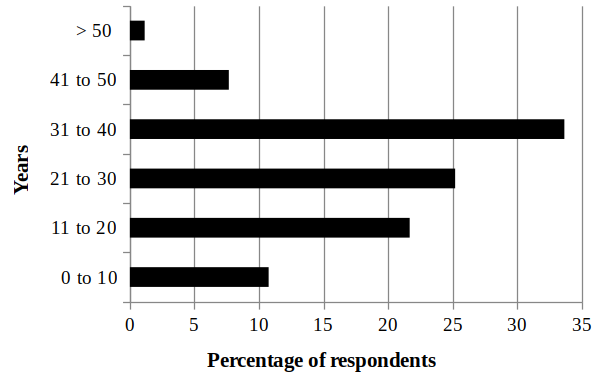
| Employer type | % of respondents |
| Private forestry consulting business | 26 |
| State forestry agency (e.g., Georgia Forestry Commission, Florida Forest Service) | 20 |
| Private forest industrial company | 18 |
| Other (includes retired forester, self-employed forester, etc.) | 9 |
| Federal natural resource agency | 9 |
| University, college, or other academic institution | 7 |
| Timber management investment organization or real estate investment trust | 6 |
| Cooperative Extension System | 3 |
| Private forestry association or organization | 2 |
| Private research firm | <1 |
Perceptions of Climate Change
Sixty-one percent of respondents agreed that climate change is occurring but varied in their beliefs about the causes of climate change; 33% were either unsure or believed that there is insufficient evidence to determine whether climate change is occurring; and 6% disputed that climate change is occurring (Figure 2). Fourteen percent of all respondents agreed that climate change is human-induced, whereas others attributed climate change to natural forces or a combination of natural forces and human causes or were unsure of the cause. Foresters' perceptions varied by state (Figure 3), with Oklahoma and Texas having the highest percentages of those who agreed that climate change is occurring (85% and 72%, respectively). Burnett and Megalos (in press) explored state-by-state trends further. Southern foresters' perspectives on climate change closely mirror other Americans' views on climate change as 63% of adults think global warming (comparable to climate change) is happening (Howe, Mildenberger, Marlon, & Leiserowitz, 2015).
Figure 2.
Southern Foresters' Perceptions of Climate Change (CC)
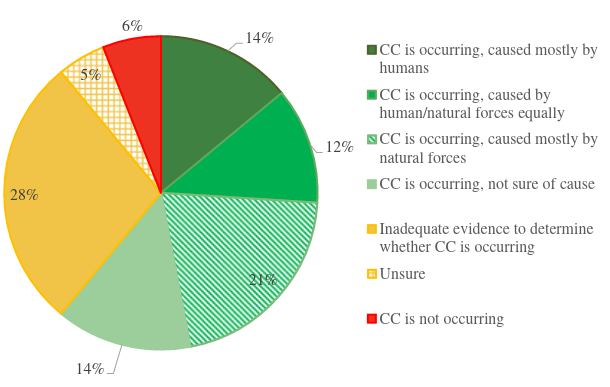
Figure 3.
Southern Foresters' Perceptions of Climate Change (CC) by State and Region (All Respondents)
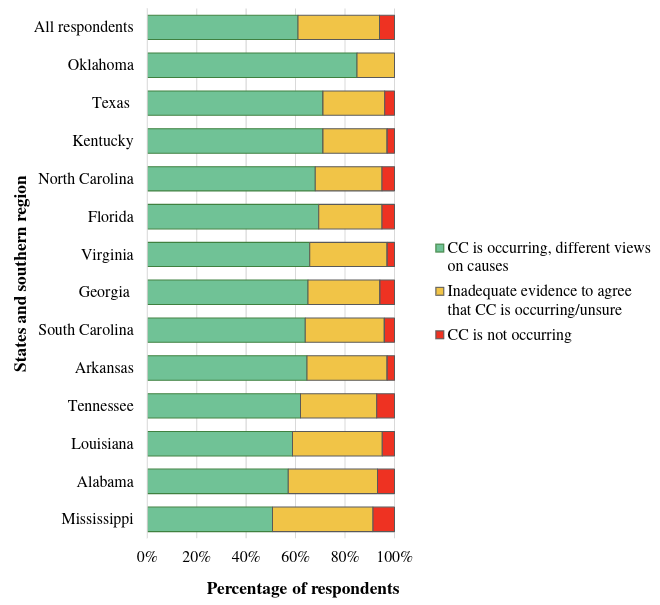
Climate Observations and Concerns
To understand the extent to which foresters have observed climate change impacts, we asked respondents to select their level of agreement with this statement: "In my lifetime, I have noticed a change in the climate (longer, hotter summers; warmer, drier winters; cooler, moister summers; earlier, drier springs; etc.)." Although the Southeast has experienced milder climate change impacts than the rest of the country (Walsh et al., 2014), 45% of respondents strongly agreed or agreed that they had witnessed changes. Of the remaining respondents, 28% neither agreed nor disagreed and 27% disagreed that they had witnessed changes.
To determine the extent to which foresters had witnessed particular changes and their levels of alarm about such changes, we asked how frequently they had experienced particular climate and weather phenomena and how concerned they were about the phenomena. Figure 4 ranks these phenomena according to the percentages of foresters who reported witnessing them very frequently or frequently and indicates foresters' accompanying levels of concern. Their levels of concern correlated with the most frequently observed climate change impacts, with invasive plant infestations and drought conditions most directly correlated. For some phenomena (drier planting seasons, fire events, insect and disease damage), the proportions of foresters who were concerned or very concerned were greater than the proportions who had observed the phenomena frequently or very frequently. Longer growing seasons due to climate change may allow time for additional insect life cycles, and drier planting seasons and increased fire events may stress trees, making them more susceptible to damage from pests and disease.
Figure 4.
Southern Foresters' Observations of and Concerns About Climate and Weather Phenomena
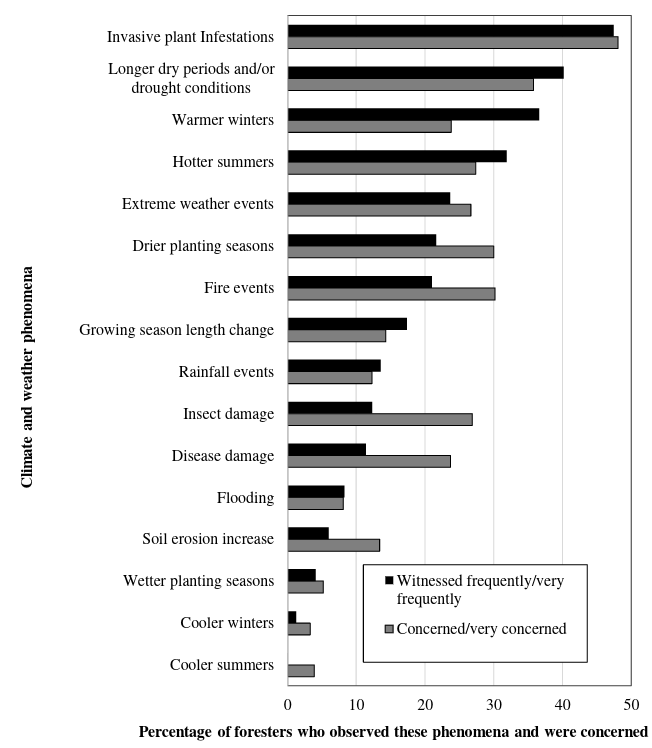
Knowledge of Climate Science, Weather, and Forest Resilience
Twenty-five percent of the respondents felt knowledgeable about climate science, whereas 40% felt only slightly knowledgeable or not knowledgeable at all. A quarter of the respondents stated that their clients had inquired about climate change and how it would affect forests, and half of the respondents indicated feeling confident in answering questions related to climate change. A majority of the respondents (62%) reported using weather tools, such as short-term and 1- to 3-month weather forecasts, soil moisture predictions, or other measurements, to assist with forest management. Of the foresters who reported using weather tools, 40% felt very or moderately confident about using them and about the results produced by the tools. About a third of these respondents felt somewhat confident using the tools, and an additional 25% were not very comfortable using them. One in three of the respondents were using climate tools specific to forest management, such as long-term climate models, the U.S. Drought Monitor, and the Keech-Byram Drought Index. Of the foresters who reported using climate tools, 42% lacked confidence in using them and in the results produced by the tools. Another 50% were somewhat or moderately confident with the tools. This finding suggests that climate tools could be promoted more extensively and that there is a need for training on using them and interpreting the results.
Increasing forest resilience is a key component of many climate change adaptation and mitigation strategies (Lenart & Jones, 2014). However, two thirds of respondents felt only slightly knowledgeable about forest resilience, and about 20% felt only somewhat knowledgeable. Just 13% felt moderately or very knowledgeable. These results could be explained partially by lack of knowledge of the definition of the term forest resilience and of ways to employ forest resilience strategies.
Continuing Education Interests
Sixty-three percent of the respondents were interested in learning more about climate science and climate change (about the same number who agreed that the climate is changing); slightly more (71%) were interested in learning more about weather (science, forecasts, tools, and technologies). These results suggest relationships between agreement that the climate is changing and interest in learning more about it.
Seventy-five percent of the respondents expressed interest in learning more about forest management strategies that promote forest health and resilience, which suggests a mechanism for introducing climate change and forest adaptation into a familiar and comfortable theme. The choice to address climate change through the lens of adaptive forest health as a topic of interest to a majority of foresters seems pragmatic and in line with Extension's role as "problem-solver" (Morris, Megalos, Vuola, Adams, & Monroe, 2014). Figure 5 shows respondents' interest levels in learning more about various topics. Generally, the foresters were most interested in specific guidance on forest management alone or in relation to weather and climate variables and change. The moderate to high levels of interest in silvics, seedling selection, genetics, and vulnerability by 50% of the respondents (Figure 5) lend credence to respondents' reported desire for "specific" recommendation and training opportunities.
Figure 5.
Southern Foresters' Levels of Interest in Learning Topics
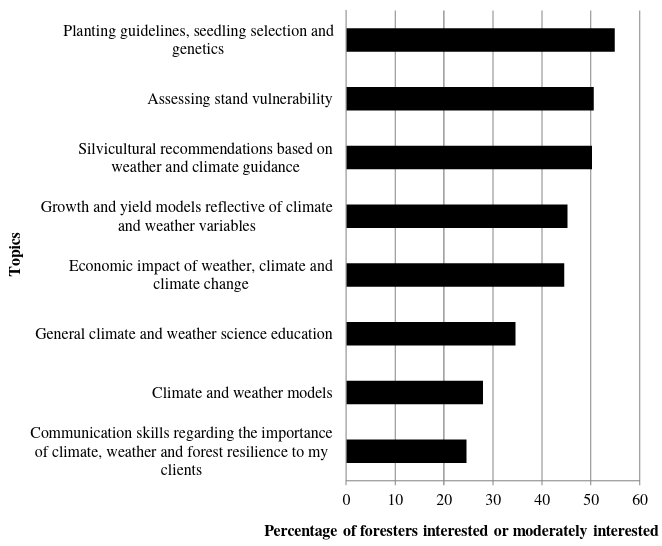
Conclusions and Implications
Southern foresters vary in their perceptions and observations about climate and weather, which contribute to their viewpoints and levels of concern about climate change. Perceptions about climate change influence concerns about possible impacts from climate change and willingness to make changes. This concept has been supported by Arbuckle et al. (2013), Jones and Lenart (2014), and Grotta, Creighton, Schnepf, and Kantor (2012). However, foresters are already concerned about specific forestry impacts from climate and weather phenomena that are likely to be exacerbated by climate change. One respondent summed up the challenge to the profession as follows: "CC [climate change] is a frequent issue in the media, so . . . folks are concerned, whether they believe CC is happening due to fossil fuels, nature, or some combination of human activities and nature."
We conclude that continuing education programs for foresters will play an important role in helping them understand and respond to climate change. Foresters are willing to learn more about climate change and forest management issues (e.g., forest resilience, climate science, weather tools). Educators can use the results of our study to design programs that address foresters' primary concerns (Figure 4) and the topics they are most interested in (Figure 5). The survey results also suggest considerable need for and possible interest in a database related to climate and weather tools and technologies that provide guidance on forest management in a changing climate as well as training materials/sessions explaining how to use them.
Extension programs for southern foresters should include multiple approaches to reach foresters with differing views on climate change and perceived needs for action. Educational programs and materials for foresters who agree that climate is changing should be developed, as these "early adopters" could disseminate information to their peers (Rogers, 2003). However, southern foresters need not be segmented on the basis of their climate change perceptions and demographics; rather, they may be brought together under the unifying concepts of forest health and productivity concerns. Risks to forest health and productivity (such as drought, insects, disease, and wildfire), which most foresters already are concerned about, are likely to be logical starting points for programming (Morris et al., 2016). Focusing education programs on reducing risks to forest health and productivity while incorporating key climate and weather concepts is becoming an accepted philosophy among Extension educators working in climate change adaptation.
Results from our study characterize how southern foresters perceive climate change and provide guidance for ways to move foresters toward managing for forest resilience, regardless of their attitudes. Figure 6 depicts an approach to education and Extension programming that is based on our findings. Education programs on adaptive forest management should include multiple approaches and components (as indicated by the orange upper boxes in Figure 6) as well as relevant educational topics (as indicated by the gray lower boxes in Figure 6).
Figure 6.
Approach to Education and Extension Programming to Increase Adaptive Climate Forest Management Actions
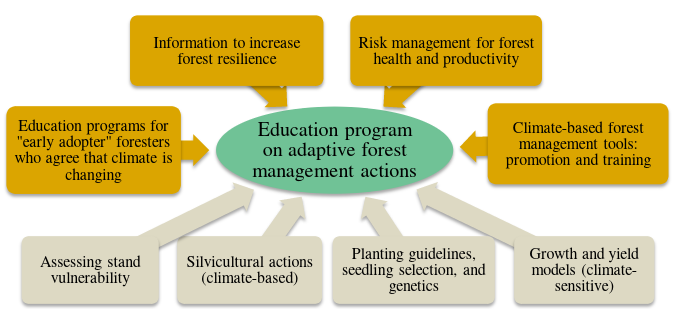
The urgent need for forest management actions to increase resilience in a changing climate is clear and though more research is warranted, our results suggest that moving forward to provide guidance on reducing forest risks and increasing resilience is a no-lose approach.
Acknowledgments
Our study was developed as a needs assessment of southern foresters for the Pine Integrated Network: Education, Mitigation, and Adaptation Project (PINEMAP). PINEMAP is a Coordinated Agricultural Project funded by the U.S. Department of Agriculture National Institute of Food and Agriculture, Award #2011-68002-30185.
References
Arbuckle, J., Prokopy, L., Haigh, T., Hobbs, J. Knoot, T., Knutson, C., . . . Widhalm, M. (2013). Climate change beliefs, concerns, and attitudes toward adaptation and mitigation among farmers in the midwestern United States. Climatic Change, 117(4), 943–950.
Bettinger, P., Siry, J., Cieszewski, C., Merry, K., Zengin, H., & Yeşil, A. (2013). Forest management issues of the southern United States and comparisons with Turkey. Turkish Journal of Agriculture and Forestry, 37(1), 83–96.
Bettinger, P., Siry, J., & Merry, K. (2013). Forest management planning technology issues posed by climate change. Forest Science and Technology, 9(1), 9–19.
Burnett, R., & Megalos, M. (in press). Southern foresters' climate observations: State comparisons and spatial trends. Journal of Human Sciences and Extension.
Butler, B. (2008). Family forest owners of the United States, (2006) (Gen. Tech. Rep. NRS-27). Newtown Square, PA: U.S. Department of Agriculture, Forest Service, Northern Research Station. 72 p.
Butler, B., Tyrell, M., Feinberg, G., VanManen, S., Wiseman, L., & Wallinger, S. (2007). Understanding and reaching family forest owners: Lessons from social marketing research. Journal of Forestry, 105(7), 348–357.
Carlton, J., Angel, J., Fei, S., Huber, M., Koontz, T., MacGowan, B., . . . Prokopy, L. (2014). State service foresters' attitudes toward using climate and weather information when advising forest landowners. Journal of Forestry, 112(1), 9–14.
Dillman, D. (2009). Internet, mail and mixed-mode surveys: The tailored design method (3rd ed.). New York, NY: John Wiley and Sons.
Grotta, A., Creighton, J., Schnepf, C., & Kantor, S. (2012). Family forest owners and climate change: Understanding, attitudes, and educational needs. Journal of Forestry, 111(20), 87–93.
Howe, P., Mildenberger, M., Marlon, J., & Leiserowitz, A. (2015). Geographic variation in opinions on climate change at state and local scales in the USA. Nature-Climate Change, 5, 596–603.
Jones, C., & Lenart, M. (2014). Forestry professionals and Extension educators vs. climate change: Implications for Cooperative Extension programming. Journal of Extension, 52(3) Article 3FEA1. Available at: http://www.joe.org/joe/2014june/a1.php
Kittredge, D. (2004). Extension/outreach implications for America's family forest owners. Journal of Forestry, 1-2(7), 15–18.
Labriole, M., & Luzadis, V. (2011). Foresters' attitudes toward the potential impact of climate change in New York. Journal of Forestry, 109(2), 89–94.
Lenart, M., & Jones, C. (2014). Perceptions on climate change correlate with willingness to undertake some forestry adaptation and mitigation practices. Journal of Forestry, 112(6), 553–563.
Morris, H., Megalos, M., Hubbard, W., & Boby, L. (2016). Climate change attitudes of southern forestry professionals: Outreach implications. Journal of Forestry, 114(5), 532–540.
Morris, H., Megalos, M., Vuola, A., Adams, D., & Monroe, M. (2014). Cooperative Extension and climate change: Successful program delivery. Journal of Extension, 52(2) Article 2COM3. Available at: http://www.joe.org/joe/2014april/comm3.php
Rogers, E. (2003). Diffusion of innovations (5th ed.). New York, NY: Free Press.
Walsh, J., Wuebbles, D., Hayhoe, K., Kossin, J., Kunkel, K., Stephens, G., & Thorne, P. (2014). Our changing climate. In J. Melillo, T. Richmond, & G. Yohe (Eds.), Climate change impacts in the United States: The third National Climate Assessment (pp. 19–67). U.S. Global Change Research Program.
Wear, D., & Greis, J. (2013). The southern forest futures project: Technical report (Gen. Tech. Rep. SRS-GTR-178). Asheville, NC: U.S. Department of Agriculture-Forest Service, Southern Research Station. 542 p.
Wojcik, D., Monroe, M., Adams, D., & Plate, R. (2014). Message in a bottleneck. Attitudes and perceptions of climate change in the Cooperative Extension Service in the southeastern United States. Journal of Human Sciences and Extension, 2(1), 51–70.
Appendix
Terms and Definitions Related to Climate Change and Forest Management
| Term | Definition |
| Adaptation | Adjustment in natural systems in response to actual or expected climate and its effects. |
| Climate | The long-term atmospheric condition (weeks to decades) in a general area (temperature, humidity, precipitation, averaged over a series of years). The frequency of rain events over a month, season, etc. is an example of climate. |
| Climate change | Change in climate based on increased concentrations of atmospheric carbon dioxide and radiative forcing (heat). |
| Climate variability | Variations in the average conditions and other statistics of climate on all temporal and spatial scales beyond that of individual weather events. El Nino Southern Oscillation is an example of climate variability. |
| Forest resilience | The capacity of forest stands to respond to disturbance by resisting damage and/or recovering quickly. |
| Mitigation | Reducing and stabilizing the levels of heat-trapping greenhouse gases (GHG) in the atmosphere and increasing GHG's sinks (or storage areas). |
| Weather | The current or short-term atmospheric condition (hours to days) at a given place (wind, temperature, cloudiness, moisture, humidity, etc.). A rain event is an example of weather. |
| Note. All definitions except the definition for forest resilience are adapted from Mach, K., Planton, S., & Von Stechow, C. (Eds.). (2014). IPCC, 2014: Annex II: Glossary. In Climate change 2014: Synthesis report. Contribution of working groups I, II and III to the fifth Assessment Report of the Intergovernmental Panel on Climate Change [Core Writing Team, Pachauri, R., & Meyer, L. (Eds.).] IPCC, Geneva, Switzerland, pp. 117–130. The definition for forest resilience is adapted from Walker, B., Holling, C., Carpenter, S., & Kinzig, A. (2004). Resilience, adaptability and transformability in social-ecological systems. Ecology and Society, 9(2), 5. | |




